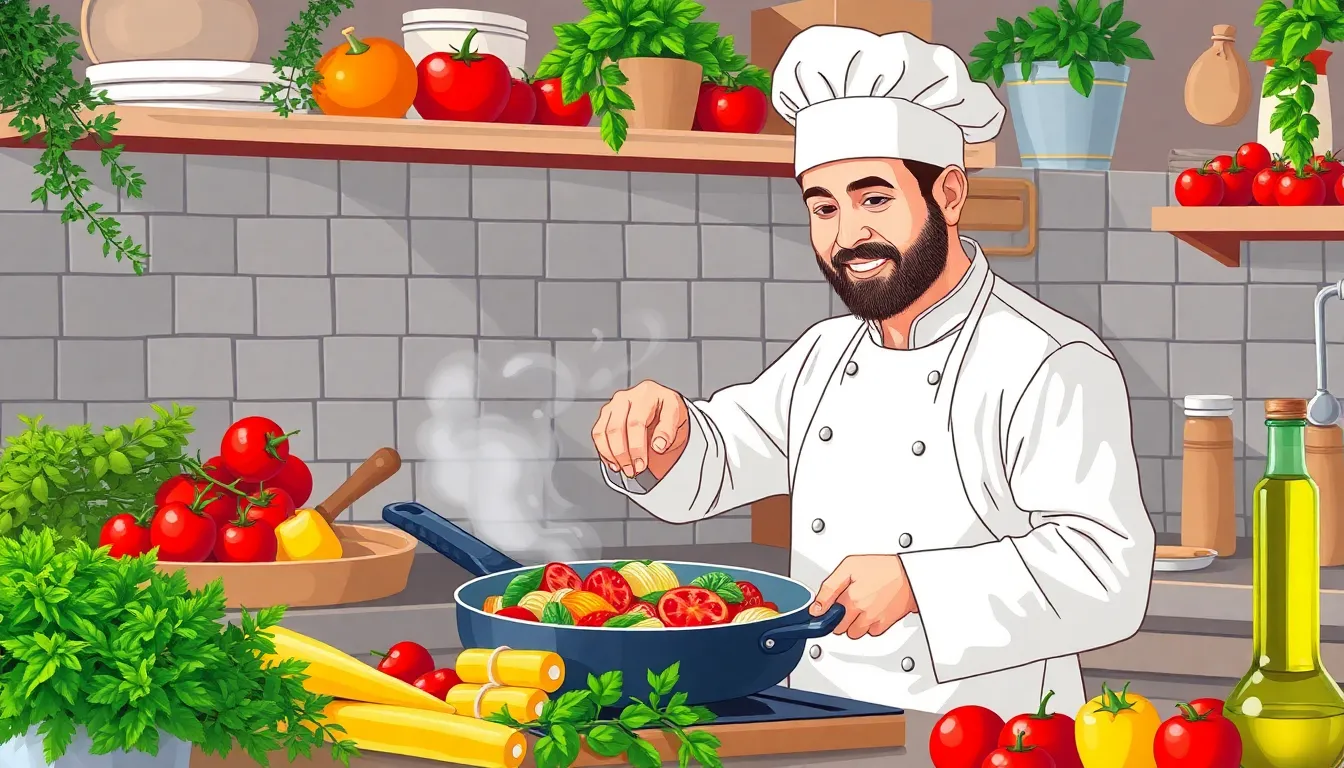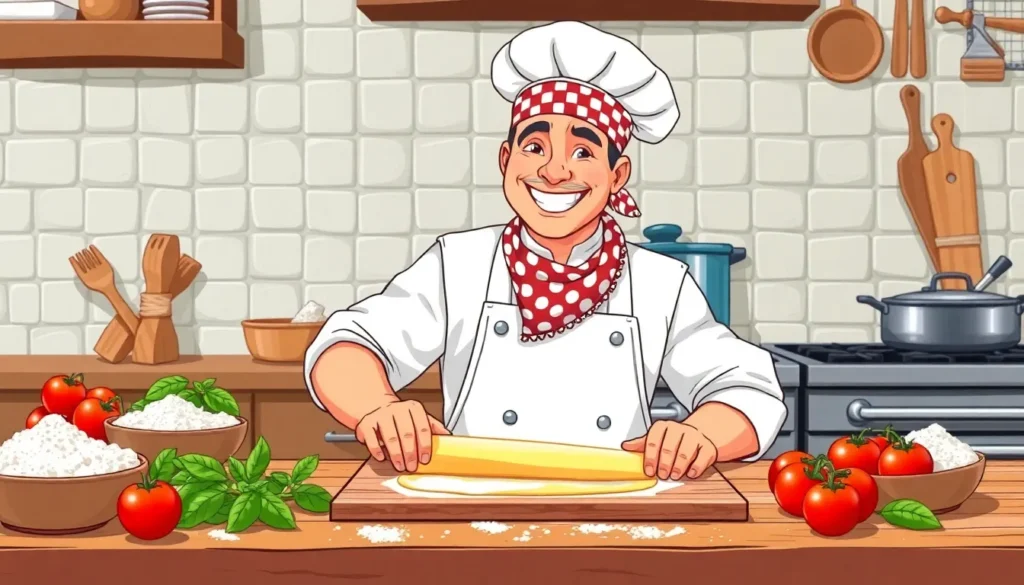Italian cooking isn’t just a meal; it’s an experience that can transport anyone straight to the sun-soaked streets of Rome or the charming hills of Tuscany. With its rich flavors and time-honored techniques, mastering Italian cuisine is like wielding a magic wand in the kitchen. From the art of perfecting pasta to the delicate dance of sautéing, these techniques are the secret ingredients to transforming any dish into a culinary masterpiece.
Table of Contents
ToggleOverview Of Italian Cooking Techniques
Italian cooking techniques play a crucial role in creating authentic dishes. Mastering these methods allows chefs to capture the essence of Italian cuisine. One foundational technique is pasta-making, which involves mixing flour and water, kneading the dough, and shaping it into various forms. Fresh pasta reflects regional variations, showcasing local ingredients.
Sautéing presents another essential skill in Italian cooking. This technique combines heat and oil to enhance flavors, often used to prepare vegetables or proteins. Proper sautéing achieves a golden brown color while retaining a dish’s natural moisture.
Roasting accentuates flavors and textures, particularly in meats and vegetables. Using high heat creates a crispy exterior, developing complex flavors. Italian cooks often utilize herbs and garlic to infuse dishes, elevating their taste profile.
Braised dishes demonstrate a slower, more deliberate method. Combining tougher cuts of meat with liquid and cooking them at low temperatures allows flavors to meld together. This technique transforms the texture of meat into a tender and savory delight.
Grilling also holds a special place in Italian cuisine. It imparts smoky flavors to meats and vegetables, enhancing their natural sweetness. Open-flame grilling provides a rustic touch, often associated with traditional Italian gatherings.
Each of these techniques holds significance in crafting memorable meals. Understanding the nuances of these methods leads to better appreciation of Italian gastronomy. Mastery of these techniques prepares chefs to create dishes that resonate with the interpretations found throughout Italy.
Essential Techniques In Italian Cooking

Italian cooking techniques showcase a variety of methods that enhance flavor and texture in dishes. Mastering these techniques ensures authenticity in Italian cuisine.
Sautéing
Sautéing involves cooking food quickly over high heat, often in olive oil or butter. This method enhances the natural flavors of ingredients while keeping them moist. Chefs often start by heating the oil and then adding aromatics like garlic or onions to build a flavorful base. Vegetables and proteins cooked this way retain their color and texture, making dishes visually appealing. A classic example is Italian stir-fried greens, where sautéing brings out the vibrant colors of vegetables while preserving their nutrients.
Braising
Braising combines cooking techniques to create tender, flavorful dishes. This method involves searing meat or vegetables first, then cooking them slowly in a small amount of liquid. The low, steady heat breaks down tough fibers, transforming meats like osso buco or chuck roast into succulent meals. Braising often incorporates aromatic herbs and spices, allowing flavors to meld. Regional variations exist, with each area infusing unique ingredients to create signature dishes, showcasing Italy’s diverse culinary landscape.
Baking
Baking is crucial for various Italian staples, including bread and pastries. This technique relies on dry heat to cook food evenly, resulting in a crispy exterior and soft interior. Italian flatbreads, such as focaccia, benefit from baking, developing a delightful crust. Traditional desserts like tiramisu and panna cotta also stem from baking processes, providing comforting, rich flavors. Regional recipes reflect local ingredients and preferences, making baking a cornerstone of Italian cooking.
Regional Variations In Techniques
Italian cooking showcases distinct regional techniques reflecting local ingredients and traditions. Understanding these variations highlights the richness of Italian gastronomy.
Northern Italy
Northern Italy emphasizes techniques like risotto-making and polenta preparation. Risotto, creamy and velvety, often uses Arborio rice and simmered broth, showcasing a method that requires constant stirring. Cream and cheese frequently enrich flavors in northern dishes, such as in the famous Risotto alla Milanese. Polenta stands as another staple, cooked slowly to achieve a smooth texture, often accompanied by hearty sauces or stews. Grilling also sees popularity in this region, particularly with meats like venison or pork, adding a charred perfection that enhances the dish.
Southern Italy
Southern Italy celebrates techniques that highlight fresh produce and seafood. Sautéing remains paramount, with garlic and olive oil creating a fragrant base for dishes such as spaghetti alle vongole. Slow cooking also holds significance, particularly in stews like cacciatore, allowing robust flavors to meld over time. Baking shines in traditional pizza and bread-making, with wood-fired ovens imparting unique flavors and textures. Additionally, preserving seasonal ingredients through canning or pickling remains a cherished method, ensuring vibrant tastes linger throughout the year.
Tools And Equipment For Italian Cooking
Essential tools and equipment enhance the Italian cooking experience, allowing for the effective application of traditional techniques.
A pasta machine simplifies the process of rolling and cutting fresh pasta, ensuring even thickness for optimal cooking.
Knives serve as indispensable tools in the kitchen, facilitating precise cutting of herbs, vegetables, and meats.
Cast iron skillets and Dutch ovens provide even heat distribution, ideal for sautéing, braising, and roasting.
A wooden spoon helps blend ingredients smoothly while preventing scratching of cookware surfaces.
Baking sheets and pizza stones are critical for achieving a crispy crust on pizzas and pastries.
Measuring cups and spoons ensure accuracy in ingredient proportions, a vital aspect in recipe consistency.
A microplane grater excels at zesting citrus and finely grating cheese or garlic, enhancing flavor profiles.
Colanders and sieves assist in draining pasta and rinsing vegetables, crucial for maintaining texture and flavor integrity.
Mortar and pestle allow for the manual grinding of spices and herbs, preserving their aromatic qualities.
Immersion blenders enable smooth pureeing of sauces and soups, providing creamy textures without needing multiple appliances.
Kitchen scales offer precise measurements, particularly useful in baking, where accuracy significantly impacts results.
Food processors streamline tasks like chopping, mixing, and emulsifying, saving time during meal prep.
These tools not only enhance the preparation process, but they also play a significant role in achieving authentic Italian flavors and presentations.
Italian cooking techniques offer a gateway to the heart of Italy’s culinary traditions. By mastering methods like pasta-making and sautéing, anyone can transform simple ingredients into extraordinary dishes. Each technique not only enhances flavors but also reflects the rich regional diversity that defines Italian cuisine.
The importance of using the right tools cannot be overstated. Whether it’s a pasta machine or a cast iron skillet, these essential items play a crucial role in achieving authentic results. Embracing these techniques and tools empowers home cooks and professional chefs alike to create memorable meals that celebrate the vibrant essence of Italian gastronomy.





